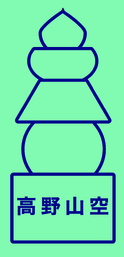
THE ELEMENTS
An overview of the elements will help visitors to identify and go deeper into the symbology of Koyasan.
Many cultures interpret the constituent elements of the Universe in some way, though these philosophies generally developed independently in different parts of the world.
In the west, the Greek philosopher Empedocles is credited with formulating the five classical elements, in 5th century BCE, proposing that all matter was composed of combinations of the "five classical elements," earth, water, air, fire, and aether or quintessence.
In Hinduism and Ayurveda, the elements are known as Pancha Mahabhutas and also consist of earth, water, fire, air, and space/ether:
Void/Ether: शून्य (śūnya) or आकाश (ākāśa)
Wind: वायु (vāyu)
Fire: अग्नि (agni)
Water: जल (jala)
Earth: पृथ्वी (pṛthvī)
In Tibetan Buddhism, the elements are referred to as the Five Pure Lights and are associated with the colors white, blue, red, green, and yellow.
In Tibetan Bön tradition, the elements are known as the Five Elements of Yungdrung Bön, and they are connected to specific qualities and directions.
On the other hand, the Chinese Wu Xing elements are wood, fire, earth, metal, and water, which have different associations and characteristics compared to those of Japan and the West.
Korea and Vietnam follow a system similar to China. In Vietnam, the elements are known as Ngũ Hành and comprise wood, fire, earth, metal, and water.
In early Buddhism, the Four Elements are a basis for understanding that leads one through unbinding of 'Rupa' or materiality (form) to the supreme state of pure 'Emptiness' or Nirvana.
In the Pali canon, the most basic elements are usually identified as four in number but, on occasion, a fifth and, to an even lesser extent, a sixth element may also be identified.
In the Śvetāśvatara Upaniṣad, (Hinduism), God is identified as encompassing the whole world – the knower, the architect of time, the one without qualities, and the all-knowing one – it is at His command that the work of creation, conceived of as earth, water, fire, air, and space, unfolds.

JAPAN
In Japan, the Five Elements are referred to as Gogyo or Godai, and a five-tier pagoda is called Gorinto, such as the three illustrations on this page.
GO-RIN-TO is written in three characters, 五輪塔, meaning five, rings, pagoda; thus a five-story pagoda or five-ring stupa.
Gorinto is also a reminder of our own constituent elements, to which we must return. In a sense, it is a reminder of our impending death and dissolution.
The elements are stacked in ascending order of subtlety, starting from Earth (represented by a cube), upwards:
Kuu (Void or Emptiness) Jewel
Fuu (Wind) Hemisphere
Ka (Fire) Pyramid
Sui (Water) Sphere
Chi (Earth) Cube
Kuu in Japanese is 空. It occurs in our name, Koyasan Space 高野山空, signifying an aspiration for enlightenment.
Sanskrit may be written in a surprising number of scripts, including the Roman.
The Buddhist scriptures that were transmitted to China, from India were in Siddham script, a script which has been preserved in Koyasan, on many Gorinto, and elsewhere.
Each layer in the Gorinto is marked with a single character inscription in Siddham. The above diagram indicates the elements with their corresponding Siddham characters, as penned by Kukai.
Void/Ether Tier: kha
Wind Tier: ha
Fire Tier: ra
Water Tier: va
Earth Tier: a
The use of Gorinto in funerary and memorial practices can be traced back to the mid-Heian period in Japan. It became a prominent feature in Shingon and Tendai Buddhist sects during that time and has continued to be used for memorial purposes in Buddhist temples and cemeteries.
We believe that remains or important items placed inside the Gorinto leads to the deceased attaining enlightenment and rebirth in the Pure Land.

KOYASAN
The five-tier gorinto are seen all over Koyasan, as 3-dimensional granite stacks. Some are tiny, just a few cm high, others are towering structures of more than 3 meters. They are especially numerous in Okunoin Cemetery, and are also way-markers on the pilgrim paths.
The five elements are also represented in long banners hanging from the temple roofs in five different colours, and also in the 5-threaded-cords, sometimes held by Kobo Daishi on one side, and the supplicant, on the other. A direct link to divinity, death, and beyond.
A recent find in a Koyasan temple revealed thousands of tiny wooden Gorinto perfectly preserved in large chests, some containing a slip of paper upon which a sutra or mantra was written, similar to Tibetan Buddhist tsa tsa. These items are stored in the Reihokan Koyasan Museum.
Kukai, the founder of the Shingon school of Buddhism in Japan, provided teachings on the Gorinto. In his writings and teachings, Kukai emphasized the symbolic significance of the Gorinto and its relationship to the Five Elements (Godai) and the esoteric teachings of the Shingon tradition.
Kukai saw the Gorinto as a representation of the cosmic principles and the integration of the Five Elements. He viewed it as a visual and contemplative tool that encapsulated the interplay and harmony of these elements, representing the entirety of existence.
The Gorinto, in this context, served as a symbolic representation of the interconnection between the physical world and the spiritual realms.
Kukai's teachings on the Gorinto also emphasized its use as a focal point for meditation and as a means to deepen one's understanding of the nature of reality. He encouraged practitioners to contemplate the symbolism of the Gorinto and its elements, aiming to cultivate insight into the interconnectedness of all phenomena and the path towards enlightenment.